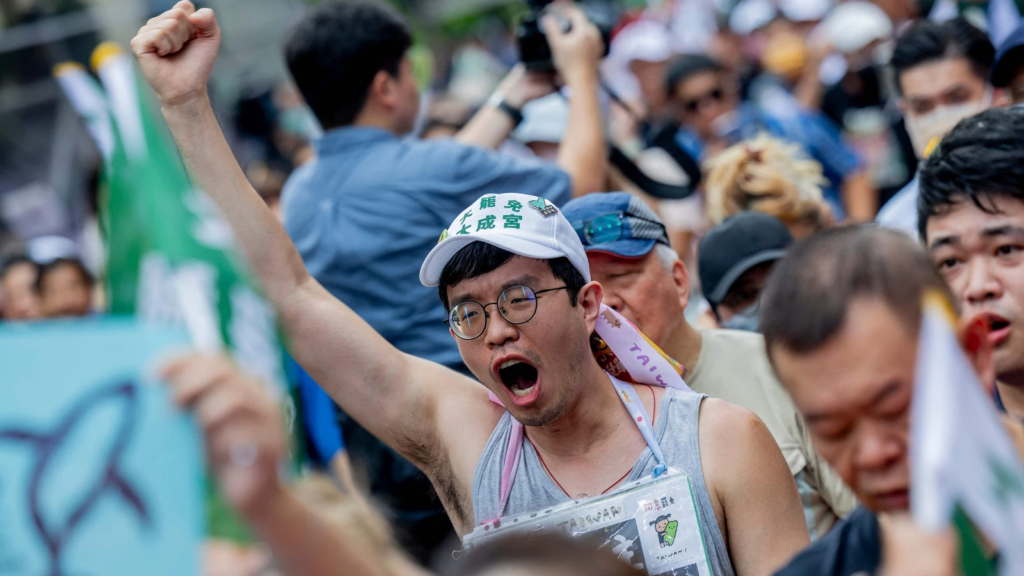Relevance: GS Paper 2: Governance, Constitution, and Politics
Context:
Recently, a recall election was held in Taiwan to remove 24 Kuomintang (KMT) lawmakers from the Legislative Yuan. In the first round, all lawmakers retained their seats, with voters rejecting their removal. A second round is scheduled for August, amid accusations of KMT’s cooperation with China.
Background of the Recall and efforts of the Bluebird Movement
- The Bluebird Movement started in 2024, protesting the opposition’s blockage of DPP bills and controversial laws. The first recall round failed to gather 25% support. The DPP needs six KMT seats for a majority, with a second round scheduled soon.
- The recall was ignited by the KMT’s introduction of controversial bills that undermined the power of the judicial and executive branches, granting excessive powers to the legislature and bypassing parliamentary deliberation. A protest in May 2024, involving 100,000 protesters, marked the peak of the Bluebird Movement, opposing the perceived violation of Taiwan’s constitution.

What is the Recall Vote About in Taiwan?
- The Taiwan Public Officials Election and Recall Act allows citizens to recall elected officials. The act includes three stages:
- Stage 1: A petition signed by at least 1% of the electorate.
- Stage 2: 10% support from the electorate.
- Stage 3: 25% of eligible voters in the district must support the recall.
- The recall petition accused KMT lawmakers of compromising national security by aligning with China’s Communist Party and pushing bills without following proper procedures. Despite this, all 24 KMT lawmakers survived the first round of the recall vote by gaining a majority in their respective districts.
Right to Recall in India in Indian context
- The concept of Right to Recall in India dates back to the 1970s when Jayaprakash Narayan, a prominent political leader, advocated for it as part of his efforts to reform Indian democracy. He believed that it would give power back to the people, allowing them to hold their elected representatives accountable.
- Certain states like Madhya Pradesh and Chhattisgarh have experimented with it for panchayat elections. In these states, the panchayat representatives can be recalled by the people if they fail to perform their duties properly. The concept remains a subject of debate in Indian political circles, with proponents arguing for more direct democracy and critics cautioning about its potential for misuse.
The pros and cons of the Right to Recall in India:
| Pros | Cons |
| Enhances Accountability: Ensures elected representatives remain answerable to the public. | Potential for Misuse: May be exploited for political vendettas or personal grievances. |
| Empowers Citizens: Gives voters the authority to remove underperforming officials. | Risk of Political Instability: Frequent recalls can disrupt governance and policymaking. |
| Promotes Transparency: Encourages officials to act in the public’s interest to avoid recall. | Administrative Challenges: The recall process can be complex, time-consuming, and resource-intensive. |
| States with Right to Recall at Panchayat Level ➡️Uttar Pradesh: Implemented in 1947; allows Gram Sabha members to initiate no-confidence motions against Sarpanchs. ➡️Uttarakhand: Implemented in 2011; enables recall of Sarpanchs and Panchayat members through a petition by at least 50% of voters ➡️Bihar: Implemented in 2006; permits recall of Sarpanchs if one-fifth of the electorate demands it. ➡️Jharkhand: Implemented in 2001; facilitates recall of Sarpanchs and Panchayat members through a petition by at least 50% of voters. ➡️Madhya Pradesh: Implemented in 2001; allows recall of Sarpanchs and Panchayat members after two and a half years in office. ➡️Chhattisgarh: Implemented in 2001; provides for recall of Sarpanchs and Panchayat members through a petition by at least 50% of voters. ➡️Maharashtra: Implemented in 2017; permits recall of Sarpanchs after two years in office through a no-confidence motion. ➡️Himachal Pradesh: Implemented in 2000; allows recall of Sarpanchs and Panchayat members through a petition by at least 50% of voters. ➡️Punjab: Implemented in 1994; enables recall of Sarpanchs through a no-confidence motion by the Gram Sabha. ➡️Haryana: Implemented in 2020; provides for recall of Sarpanchs and Panchayat members through a petition by at least 50% of voters. States with Right to Recall at Municipal Level ➡️Madhya Pradesh: Implemented in 2001; allows recall of Municipal Corporation members through a petition by at least 50% of voters. ➡️Chhattisgarh: Implemented in 2001; permits recall of Municipal Corporation members through a petition by at least 50% of voters. ➡️Bihar: Implemented in 2006; facilitates recall of Municipal Corporation members through a petition by at least 50% of voters. ➡️Jharkhand: Implemented in 2001; enables recall of Municipal Corporation members through a petition by at least 50% of voters. ➡️Rajasthan: Implemented in 2009; allows recall of Municipal Corporation members through a petition by at least 50% of voters. |
Conclusion
The July 26, 2025, Taiwan recall election revealed the complexities of using the recall mechanism to resolve political disputes. Despite the Bluebird Movement mobilizing public opinion against the Kuomintang (KMT), all 24 targeted lawmakers retained their seats, highlighting challenges in meeting legal thresholds. Similarly, India’s experience with the Right to Recall at the panchayat and municipal levels reflects ongoing debates about its effectiveness and potential for misuse. Both cases underscore the need for carefully designed recall mechanisms to ensure they serve their intended purpose without undermining democratic stability.
| Prelims practice question Q. Consider the following statements regarding the Right to Recall in India: The Right to Recall allows citizens to remove elected representatives from office before their term ends. India has implemented the Right to Recall at the national level for Members of Parliament (MPs) and Members of Legislative Assemblies (MLAs). Certain states in India, such as Madhya Pradesh, Chhattisgarh, and Bihar, have implemented the Right to Recall at the panchayat and municipal levels. Which of the above statements are correct? A) 1 and 2 only B) 2 and 3 only C) 1 and 3 only D) 1, 2, and 3 Mains practice question Q.”Critically examine the implications of the Right to Recall on India’s democratic framework. Discuss its potential benefits and challenges, and evaluate the feasibility of implementing such a mechanism at the national level.” 15 marks (250 words) |
Source: The Hindu
